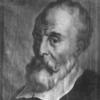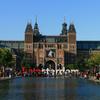More about Portrait of Daniele Barbaro

Sr. Contributor
They're the three best friends that anyone could have. Barbaro and Veronese were BFFs, with their three-way bromance completed by local architect Palladio.
The Veneto magnate is single-beardedly responsible for throwing commissions toward both Veronese and Palladio, landing each right in the lap of utter, decadent success. Veronese's spoils from his schmoozing with Barbaro even included a fly as hell gold chain awarded by none other than grand master Titian for the decoration of a famous library.
So, obviously, when Veronese is called to portray his good friend and breadwinner, he really lays on the visual kudos for a life spent making the world a better-educated place. Barbaro was a leading scholar of Aristotelian physics, but was most concerned with merging the fields of philosophy, the arts, and the sciences in a way that people could actually benefit from. Venice made him ambassador to England for a time before granting him local titles of power and authority until he, finally, was put in charge of the history of the Republic. Nerd alert aside, how many people do you know get told they're in charge of every fact about America? No one. There's no position like that now because we'd get things worse than what the rednecks in Texas do to primary school textbook standards.
But, if we're to take Veronese's opinion as anything, Barbaro was up to the responsibility. In this portrait, he's gussied up in the clothing of a scholar and is posed like Raphael's portrait of Pope Julius II. Cause, you know, he's a smart and holy guy. The book he holds is a mix of vertical integration and a shout out to Palladio. It's the translation of a tract on architecture by Roman scholar Vitruvius, translated by Barbaro and illustrated by Palladio.

Contributor
Daniele was a Renaissance man squared:
1) He studied math, engineering, philosophy
2) He translated the works of the Roman architect Vitrivius, and then himself became one of the top architects in Venice
3) He was ambassador to England
4) He became a cardinal, and served on the Council of Trent (a club of Catholic bigwigs in charge of dissing Protestants)
5) He collected astronomical instruments
On top of all of this, he was also modest, and gave up his share of his family's inheritance to his brother. For this generosity, he was buried in an unmarked grave.
He looked very distinguished though, in his cardinal getup, surrounded by architectural drawings and books. Although we have to wonder why the last two buttons of his crop top are undone...
His beard is epic, his dress- not so much.
Featured Content
Here is what Wikipedia says about Portrait of Daniele Barbaro
The Portrait of Daniele Barbaro is an oil on canvas painting by the Italian Renaissance master Paolo Veronese, from c. 1556-1557. It is held in the Rijksmuseum, in Amsterdam. Daniele Barbaro was a member of the Venetian aristocracy (see Barbaro family). He was an important prelate, humanist and architectural theorist, who commissioned a number of works from Veronese. Veronese had been involved directly with Barbaro and his brother Marcantonio Barbaro, decorating the Villa Barbaro, Maser, which Palladio designed.
Barbaro, who was Patriarch of Aquileia, is dressed as a bishop. From 1561 he was also a cardinal; although this appointment was in pectore (not made public) he is sitting in the audience posture (reserved normally for Popes and cardinals).
The book standing up is the La Practica della Perspettiva, Barbaro's treatise on artistic perspective. The other volume on the table is Barbaro's "Commentary" on Vitruvius' De architectura, which has illustrations by Andrea Palladio.
Barbaro's Commentary on Vitruvius was published in Italian in 1556, but the portrait may be linked to the publication of a second edition in Latin in the 1560s.
Check out the full Wikipedia article about Portrait of Daniele Barbaro












